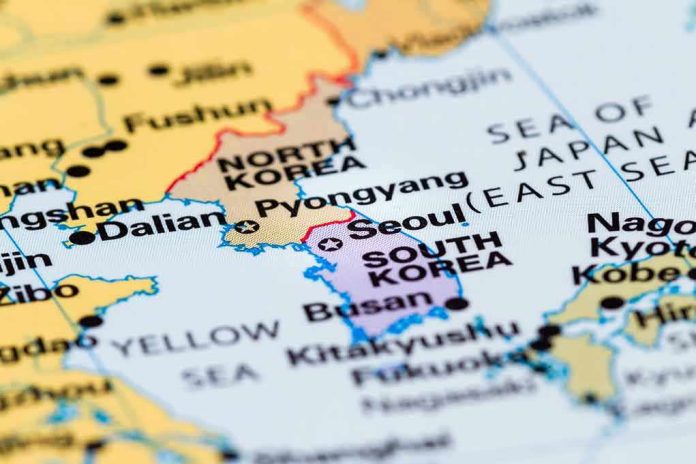
Trump’s historic decision to arm South Korea with U.S. nuclear submarine technology sends shockwaves through Washington and rattles adversaries in Beijing and Pyongyang.
Story Snapshot
- The U.S. will share nuclear submarine technology with South Korea for the first time in history.
- Construction will take place at a commercial U.S. shipyard recently bought by a South Korean conglomerate.
- The policy aims to counter growing threats from North Korea and China while revitalizing American shipbuilding.
- Major technical, political, and regulatory challenges could delay or complicate the initiative.
Trump’s Policy Breaks with Decades of Precedent
President Trump’s October 2025 announcement to share advanced nuclear submarine technology with South Korea marks a dramatic shift in American defense policy. Previously, only the United Kingdom and Australia benefited from such technology transfers, reflecting longstanding U.S. concerns about nuclear proliferation and regional stability. Trump’s move responds directly to increasing North Korean missile tests and China’s naval buildup, signaling a new era of strategic cooperation intended to deter adversaries and reinforce the U.S.-South Korea alliance.
The deal will allow South Korea to construct its own nuclear-powered submarine at the Hanwha Philly Shipyard in the United States. Hanwha, a major Korean conglomerate, acquired the shipyard in 2024, creating a unique partnership that blends U.S. nuclear expertise with Korean industrial capacity. The announcement comes as the American shipbuilding sector faces significant delays and supply chain bottlenecks, raising questions about the project’s implementation timeline and feasibility. Trump’s supporters view the move as a necessary response to regional threats and a bold step to restore U.S. industrial strength.
Strategic and Industrial Motivations
Trump’s initiative is intended to address multiple security and economic objectives. By equipping South Korea with nuclear submarine capabilities, the U.S. aims to bolster a key ally’s deterrence against North Korea and China, two regimes known for their hostility to American interests. The partnership also positions the U.S. to regain lost ground in military manufacturing, potentially creating jobs and revitalizing an industry strained by years of neglect and bureaucratic inefficiency. The deal is framed as a win for American workers and a reaffirmation of U.S. leadership in global defense technology.
The transfer of nuclear submarine technology to a non-UK, non-Australian ally is unprecedented and faces scrutiny from Congress, industry experts, and international observers. Trump’s administration retains strict control over the technology’s transfer and regulatory oversight, ensuring that U.S. national security interests remain paramount. South Korea, while gaining significant capability, will rely on American guidance and approval throughout the process, reflecting a clear hierarchy within the alliance. Hanwha’s role as shipyard owner bridges the interests of both nations, but also introduces new complexities regarding workforce training and industrial standards.
Logistical and Political Challenges Ahead
Building a nuclear-powered submarine in a commercial yard presents daunting challenges. The Hanwha Philly Shipyard lacks experience with sensitive military projects, and the broader U.S. shipbuilding sector is already grappling with skilled labor shortages and persistent delays. Analysts warn that retrofitting the yard to meet nuclear standards could take years, potentially delaying delivery and increasing costs. Meanwhile, regulatory and environmental approvals will require close coordination between U.S. agencies, Congress, and allied officials, adding further layers of complexity to the initiative.
Political opposition and diplomatic risks loom large. China and North Korea have already voiced concerns, threatening retaliation and heightened military posturing in the region. At home, critics question whether the deal could undermine U.S. commitments to nonproliferation or stretch America’s industrial base too thin, especially with ongoing supply chain issues. Supporters counter that, given the stakes, decisive action is needed to protect American interests, defend allies, and send a clear message to hostile regimes that the U.S. will not retreat from its leadership role.
Long-Term Implications for U.S. Security and Industry
If successful, the project could transform the security landscape in Northeast Asia, making South Korea only the third nation to operate U.S.-designed nuclear submarines. This shift is likely to strengthen deterrence against aggression from North Korea and China, while deepening the U.S.-South Korea partnership. The deal may also set a precedent for future technology sharing with other trusted allies, although it could fuel regional arms races and complicate efforts to limit nuclear proliferation.
The broader impact on American industry remains uncertain. While the initiative could catalyze investments in shipbuilding and create high-skilled jobs, it also risks exacerbating existing bottlenecks if not properly managed. Congress and the administration must navigate complex legal, industrial, and diplomatic terrain to ensure the plan strengthens, rather than undermines, U.S. security and economic interests. For many frustrated conservatives, this bold move represents a long-overdue effort to reverse years of bureaucratic inertia, globalist appeasement, and erosion of America’s defense edge.
Sources:
Trump Will Arm South Korea With a Nuclear Submarine
Seoul’s Nuclear Submarine Breakthrough
Game Changer: Trump Approves South Korea’s Nuclear Submarine Ambition
USA Gives South Korea Green Light to Build Nuclear Submarines







